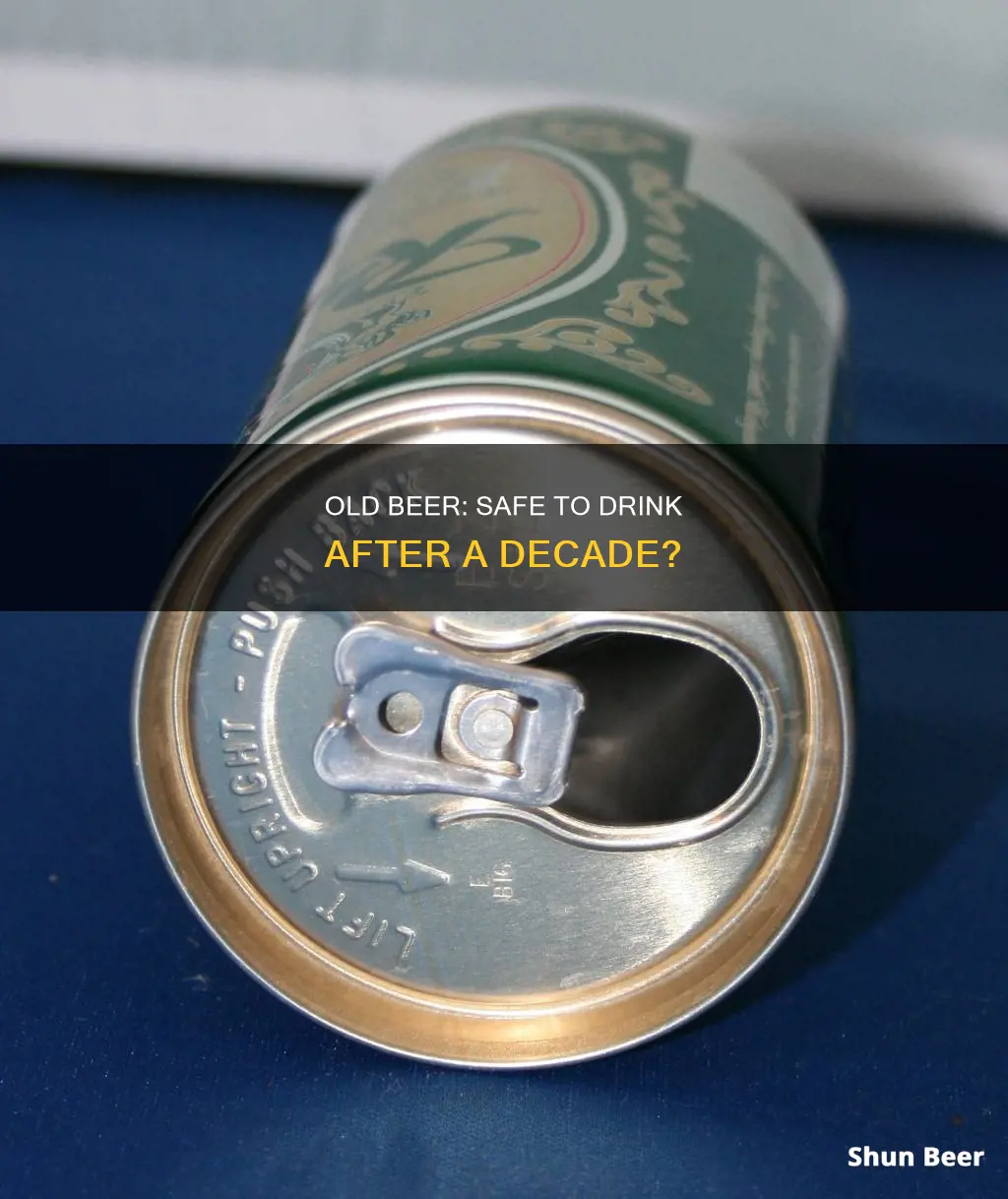
Drinking a beer that's a decade old is generally safe. However, the beer's taste will likely have changed. Beer is susceptible to light, oxygen, heat, and time, which can cause it to spoil or skunk. Oxidation, in particular, can cause the beer to stale, resulting in cardboard-like aftertastes. Additionally, the higher the alcohol content, the less concerned you need to be about the use-by date.
| Characteristics | Values |
|---|---|
| Is it safe to drink? | Yes, it is safe to drink decade-old beer. |
| Taste | The beer will not taste good. It will be stale and have a cardboard-like aftertaste. |
| Health benefits | There is no evidence that decade-old beer has the same health benefits as fresh beer. |
| Alcohol content | The alcohol content of the beer will be higher. |
| Fizziness | The beer will lose its fizziness. |
What You'll Learn

Beer doesn't expire, but its flavour profile changes over time
Beer doesn't expire in the same way that perishable foods do, but its flavour profile does change over time. While it's generally safe to drink, a beer past its prime may disappoint your palate.
Beer is made from organic plant ingredients that will eventually decay. Brewers work to make beer last as long as possible, and they have some major advantages: the alcohol content, beer's low pH, and the antimicrobial activity of hops. When properly brewed and packaged, the only things in your beer are the ingredients and a small amount of air.
However, oxygen in the beer can react with its chemical makeup, breaking down hop oils and other flavour compounds. This can result in off-flavours such as a cardboard-like or stale taste, and a reduction in aroma. Beers in clear or green bottles can also become "skunky" when exposed to UV light due to a photochemical reaction between UV light and hop compounds in the beer.
Temperature also plays a role in flavour changes. High temperatures accelerate chemical reactions that break down flavour compounds, and freezing can cause the beer to expand, potentially breaking the container and introducing oxygen upon thawing.
Over time, all beer will undergo chemical changes that alter its flavour, aroma, and mouthfeel. Aging causes the aromas and hop flavours to mellow, and the malt flavour to become stronger. This is desirable for some people, but for others, it can mean a loss of the beer's intended profile.
While beer doesn't expire, drinking expired beer isn't recommended as it can be unpleasant and undesirable. Commercially produced beer generally has a shelf life of 6 to 12 months past the printed expiration date when stored in a cool, dark place. However, high-ABV beers such as barley wines and imperial stouts can last for years and improve with age due to the stabilizing effect of higher alcohol content.
Beer and Keppra: Is One Drink Okay?
You may want to see also

Beer is safe to drink even after its 'best before' date
Beer is generally safe to drink even after its 'best before' date. This is because, unlike 'use by' dates, which are a rule, 'best before' is more of a guideline on quality rather than safety. Beer is fully fermented, so no harmful pathogens will grow inside the bottle. This means that even decade-old beer is safe to drink.
However, the taste of the beer will likely be affected. The longer a beer is left, the more oxidised it will get, which will cause the beer to stale and produce off flavours such as cardboard, sherry, paper, and soy sauce. Hop aromas will also be muted, and other forms of staling can lead to a soapy taste.
The type of beer will also affect how well it ages. Beers with higher alcohol content will keep for longer, as the more robust flavours can mask any ongoing oxidation. Richer and higher ABV varieties of beer, such as porters and stouts, can improve with age, especially if they are kept in cool, dark storage conditions. IPAs, on the other hand, do not age well, and will lose their flavour and aroma over time.
Beers: The Safest Alcoholic Beverage?
You may want to see also

The taste of old beer is often described as cardboard-like
Oxidation causes the formation of an aldehyde called 2-nonenol, which gives beer its cardboard-like taste and smell. This chemical is also found in the sweat of older people, which is why some describe the smell of old beer as "old people smell".
While old beer may taste unpleasant, it is usually safe to drink. Canned or bottled beers are already fully fermented, so no harmful pathogens will grow inside them. However, the taste of beer does not improve with age, and old beer will not have the flavour you are looking for.
Beer and Diarrhea: Should You Drink or Ditch?
You may want to see also

Beer should be stored in a cool, dark area to avoid spoilage
Beer is best stored in a cool, dark area to avoid spoilage.
The temperature, container, time of bottling, and the variant of the beer are all factors to consider when storing beer. Beer is an organic substance, meaning it contains chemical compounds from living things, namely yeast. Improper storage allows the following factors to affect the beer and lead to spoilage: exposure to sunlight, exposure to oxygen, and the presence of bacteria.
Sunlight creates a chemical reaction in the beer, breaking down its flavour components until the beverage smells and tastes like skunk spray. Beer stored in direct sunlight for too long is said to have been "skunked" or "lightstruck". Beer is often stored in dark bottles to protect the liquid from the sun's UV rays.
Overexposure to oxygen leads to a breakdown of the beer's chemicals, which can significantly alter the taste. Bottled beer is at a higher risk of exposure to oxygen than canned beer, and storing beer upright minimises contact with the air.
Bacteria is an unusual culprit as it can be hard for it to survive in beer thanks to its high alcohol content, which acts as a natural preservative. However, if bacteria does make its way into the beer, it will eat away at it. Commercial brewers take great pains to reduce bacterial contact, but you can increase craft beer shelf life by refrigerating it.
The colder temperature slows the life cycle of microbes that live in the beer, such as the yeast used to create it. The ideal temperature for storing beer is between 45 and 55 degrees Fahrenheit. Beer should also be stored upright to prolong its shelf life.
In addition to storing beer in a cool, dark area, it is also important to consider the type of beer, the temperature, and the amount of movement when storing beer for aging. Full-bodied, high-ABV beers usually age well in the right conditions. Lighter, hoppier brews like pale ales, IPAs, and wheat beers are not good candidates for cellaring because the hops will break down over time.
The temperature of the beer cellar should be kept fairly cool, as too warm will accelerate aging and oxidation. It is recommended to keep the beer cellar around 10 degrees below the beer's fermentation temperature. The beer should also be stored in a dark place where it won't be exposed to direct sunlight to prevent skunking.
Lastly, it is important to minimise movement when storing beer for aging as too much movement can cause chemical changes, affecting its overall flavour.
Dented Beer Can Drinking: Safe or Not?
You may want to see also

Beers with higher alcohol content tend to keep longer
While drinking a decade-old beer is generally safe, it is not recommended due to the unpleasant taste it may have developed over time. Beer is best consumed as close to the brew date as possible to maximise the flavour and aroma profile.
The key factor in determining the alcohol content of beer is the amount of fermentable sugar available for the yeast to convert into alcohol during fermentation. Brewers can control the alcohol content by adjusting the amount of barley, malted barley, or other grains used in the brewing process.
Additionally, the storage conditions play a crucial role in preserving the quality of aged beer. It is recommended to store beer in a dark, well-sealed barrel in a cold, dark room, ensuring that it never sees the light of day to prevent off-flavours caused by UV rays.
When it comes to ageing beer, the ideal storage time is around six months to allow for maximum impact on the beer's flavour. Beers with higher alcohol content, typically between 7% and 9%, are better suited for ageing as the alcohol acts as a preservative. These beers can develop more complex flavours and characteristics over time. However, it is important to manage expectations, as aged beers may not always taste better, especially those with lighter flavours.
Beer Drinking and Heaven: What's the Verdict?
You may want to see also
Frequently asked questions
Yes, it is safe to drink beer that is past its "best before" date. No harmful pathogens will grow in the beer, even if it is decades old. However, the taste will be affected.
Over time, the beer will oxidise, which will cause it to stale. Hop aromas will be muted, and other flavours will emerge, such as cardboard, paper, or sherry.
Beers with a higher alcohol content will be less affected by the "best before" date. Bottle-conditioned beers with an ABV of 9% or higher will be fine if aged for over a year. Lambics, gueuzes, and saisons can also taste good after ageing for many years.







